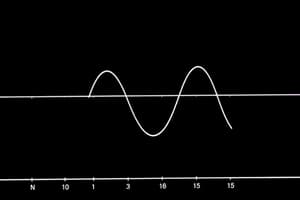Podcast
Questions and Answers
Why does reacting baking soda and vinegar proceed faster than the rusting of iron?
Why does reacting baking soda and vinegar proceed faster than the rusting of iron?
- The activation energy for the baking soda and vinegar reaction is higher.
- Reaction Kinetics dictates that reactions involving organic compounds are slow
- Rusting requires a more complex reaction mechanism. (correct)
- Rusting involves the production of gaseous products, which slows down the reaction.
What is the focus of the chemistry branch known as reaction kinetics?
What is the focus of the chemistry branch known as reaction kinetics?
- Measuring the energy released or absorbed during a chemical reaction.
- Determining the equilibrium constants of chemical reactions.
- Analyzing the thermodynamic stability of chemical compounds.
- Understanding the rate and mechanism of chemical reactions. (correct)
Under what temperature conditions is the production of Hydrogen Iodide (2HI) favored from Hydrogen gas and Iodine gas?
Under what temperature conditions is the production of Hydrogen Iodide (2HI) favored from Hydrogen gas and Iodine gas?
- The reaction occurs spontaneously regardless of temperature.
- Low temperatures favor the production of Hydrogen Iodide
- High temperatures favor the decomposition of Hydrogen Iodide. (correct)
- Temperature has no effect on the Hydrogen and Iodine gas reaction.
Why are reaction mechanisms important in understanding chemical reactions?
Why are reaction mechanisms important in understanding chemical reactions?
Which statement accurately describes the role of an intermediate in a reaction mechanism?
Which statement accurately describes the role of an intermediate in a reaction mechanism?
In the reaction mechanism: $NO_2 + CO \rightarrow NO + CO_2$, what is the role of $NO_2$?
In the reaction mechanism: $NO_2 + CO \rightarrow NO + CO_2$, what is the role of $NO_2$?
What are the two crucial requirements for reactant particles to effectively cause a chemical reaction, according to the collision theory?
What are the two crucial requirements for reactant particles to effectively cause a chemical reaction, according to the collision theory?
Why does the equation $C_3H_8(g) + 5O_2(g) \rightarrow 3CO_2(g) + 4H_2O(g)$ not fully represent the entire burning mechanism of propane?
Why does the equation $C_3H_8(g) + 5O_2(g) \rightarrow 3CO_2(g) + 4H_2O(g)$ not fully represent the entire burning mechanism of propane?
According to the collision theory, why might a collision between two reactant molecules not result in a chemical reaction?
According to the collision theory, why might a collision between two reactant molecules not result in a chemical reaction?
What determines whether the collisions will bring correct atoms together and be properly aligned for the molecule to react?
What determines whether the collisions will bring correct atoms together and be properly aligned for the molecule to react?
How is the activated complex best described?
How is the activated complex best described?
According to a potential energy diagram, what does a positive $ΔE$ indicate about a reaction?
According to a potential energy diagram, what does a positive $ΔE$ indicate about a reaction?
In potential energy diagrams, what part represents how activated complexes come to be?
In potential energy diagrams, what part represents how activated complexes come to be?
Suppose a reaction proceeds through three activated complexes. How many total 'steps' are involved in the transition of the reaction?
Suppose a reaction proceeds through three activated complexes. How many total 'steps' are involved in the transition of the reaction?
In a reaction coordinate diagram, what does the difference in energy between the reactants and the activated complex represent?
In a reaction coordinate diagram, what does the difference in energy between the reactants and the activated complex represent?
If $\Delta E_{forward}$ for a reaction is 50kJ/mol, what conclusions can be made about $\Delta E_{reverse}$?
If $\Delta E_{forward}$ for a reaction is 50kJ/mol, what conclusions can be made about $\Delta E_{reverse}$?
Using a given graph, the products are measured at 75kJ/mol, while the reactants are measured at 25kJ/mol. What can be determined about $\Delta E_{forward}$?
Using a given graph, the products are measured at 75kJ/mol, while the reactants are measured at 25kJ/mol. What can be determined about $\Delta E_{forward}$?
With an activated complex is measured at 100kJ/mol, and the products measured at 75kJ/mol, what is $E'_a$?
With an activated complex is measured at 100kJ/mol, and the products measured at 75kJ/mol, what is $E'_a$?
How can you calculate the activation energy ($E_a$) for a forward reaction using a potential energy diagram?
How can you calculate the activation energy ($E_a$) for a forward reaction using a potential energy diagram?
Flashcards
What is Reaction Kinetics?
What is Reaction Kinetics?
The branch of chemistry that studies how quickly a chemical reaction takes place.
What is a Reaction Mechanism?
What is a Reaction Mechanism?
A step-by-step sequence of reactions showing the overall chemical change.
What is an Intermediate?
What is an Intermediate?
A chemical species that appears in a step of a mechanism, but is not in the net equation.
What is Collision Theory?
What is Collision Theory?
Signup and view all the flashcards
What is Activation Energy?
What is Activation Energy?
Signup and view all the flashcards
What is an Activated Complex?
What is an Activated Complex?
Signup and view all the flashcards
What is E
a?
What is E a?
Signup and view all the flashcards
What does ΔΕ indicate?
What does ΔΕ indicate?
Signup and view all the flashcards
Study Notes
Speed of Chemical Reactions
- Some chemical reactions are fast while others are slow
- Reacting baking soda (NaHCO3) and vinegar (CH3COOH) produces sodium acetate, carbon dioxide, and water quickly
- Rusting, the process of iron reacting with oxygen gas and water to form hydrated Iron (III) Oxide, is a slow process
- Reaction kinetics studies how quickly a chemical reaction takes place
Reaction Mechanisms
- A reaction between hydrogen gas and iodine gas produces hydrogen iodide gas at high temperatures, shown as: H2(g) + I2(g) → 2HI(g)
- At low temperatures, hydrogen iodide molecules can decompose and reform hydrogen gas and iodine gas: 2HI(g) → H2(g) + I2(g)
- These reactions indicate which chemical species are used and created
Reaction Mechanism
- A step-by-step sequence of reactions for an overall chemical change
Importance of understanding reaction mechanisms
- Essential to display the overall process, showing why certain parts of the reaction take longer
Intermediates in Mechanisms
- An intermediate is a chemical species that appears within a step but isn't in the net equation
- In the overall reaction NO2 + CO → NO + CO2, which occurs in steps, NO3 is an intermediate
- NO3 is an unnecessary product needed to make NO, then it reacts with CO
- NO2 acts as a catalyst
Collision Theory
- For chemical reactions to occur, particles (molecules, atoms, ions) must collide
- Collision theory states that reactant particles must collide with enough energy and proper orientation for a chemical reaction to occur
- Chemical reactions involve breaking bonds between atoms/ions and creating new ones
- Reactions need bring the atoms together in the right orientation
- A chlorine molecule colliding with the oxygen end of a nitrogen monoxide molecule could result in NO(g) + Cl2(g) → NOCl(g) + Cl(g)
- The reaction won't happen if the chlorine molecule hits the nitrogen end of the molecule
Activation Energy
- Activation energy is the minimum energy to transform reactants into an activated complex
Activated Complex
- Activated complex is the transitional state, existing briefly during a collision, where reactants' bonds break and reform to make products
Potential Energy Diagram
- Potential energy diagrams describe aspects of chemical reactions
- Eₐ, pronounced E sub A, is the activation energy in kilojoules/mol for the forward reaction
- E'ₐ, pronounced E sub A prime, is the activation energy in kilojoules/mol for the reverse reaction
- ΔE is the change in energy: positive indicates an endothermic reaction, negative an exothermic reaction
Potential Energy Diagram (Cont.)
- Indicates three steps in the reaction H2 + I2 → 2HI represented by three activated complexes
- Step 1: Molecular iodine separates into iodine atoms
- Step 2: One separated iodine atom joins the hydrogen atoms
- Step 3: A hydrogen atom separates and pairs with the other unbonded iodine
Studying That Suits You
Use AI to generate personalized quizzes and flashcards to suit your learning preferences.




